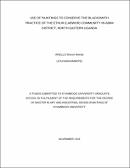| dc.description.abstract | The purpose of this study entitled Use of paintings to conserve the blacksmith practice of Ethur (Labwor) people in Abim District North Eastern Uganda is to document and conserve the blacksmith practice of the Ethur (Labwor) people using paintings. The objectives of the research project were, to analyze the perceptions of the community about blacksmith practice among the Ethur (Labwor) community in Abim District North Eastern Uganda, to document the blacksmith process of the Ethur (Labwor) community and to produce painting that conserve the Blacksmith practice of the Ethur (Labwor) community. The study was carried out in the Ethur (Labwor) community in Abim District. The research design was ethnography where by seven key respondents were purposely selected. In-depth interviews, Focus Group Discussions (FDGs), Photography and studio experimentation were used to collect data. The findings indicate that not so many people today do not understand blacksmith practice, because technology has affected the way people live, it has affected the systems and means of production and changed the kind of tools used, and the approaches and methods used in production of domestic and agricultural tools. More so, findings indicate that the blacksmith practice is one of the cultural heritages and can be used to promote the Ethur (Labwor) culture as well as source of livelihood for domestic and agriculture purposes. The findings further indicate that the practice has declined due to the negative perception which the people have about the blacksmith practice. To moderate this negative perception, and preserve the importance of this practice, the researcher developed four processes in painting for conservation of the Blacksmith practices that included working the bellows (Lor buk), forging process (Teth), the smelted products (Theno), and the Thur family. The study recommends that more indigenous practices should be documented and conserved through painting or other visual means, policy makers should support the conservation of indigenous practices as Blacksmith practices for the future generation, artists should also produce artworks that narrate, communicates, conserve and solve problems in society which reveals the importance of visual art in the society. | en_US |

